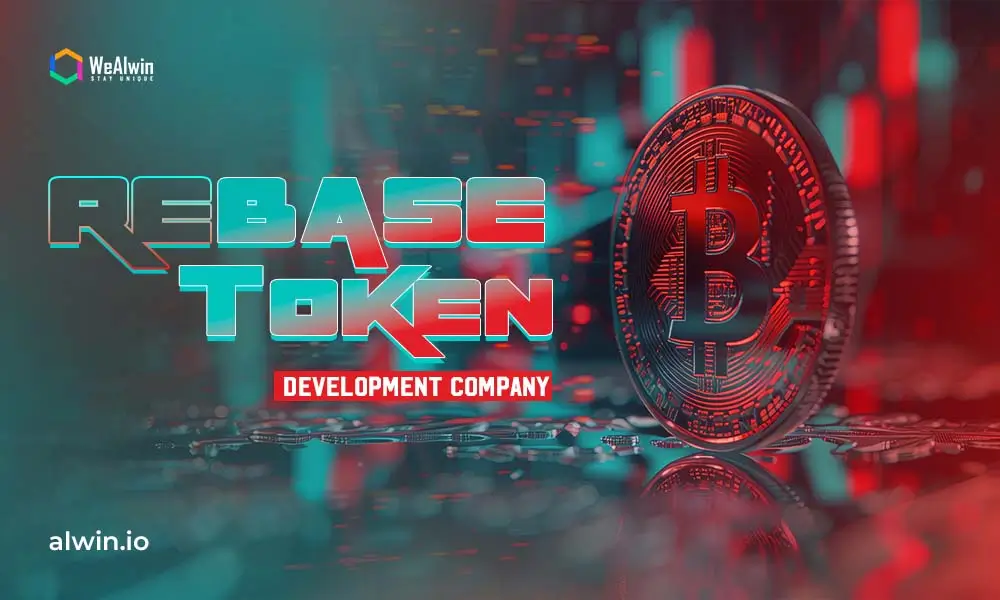Cryptocurrency is an ever-evolving platform that provides various types of digital currencies for buyers and sellers. Along with cryptocurrency development, tokens play a vital role in the extensive landscape, providing digital assets that represent an asset on a cryptocurrency’s blockchain. There are various tokens available, each offering a variety of solutions and benefits for users. Comparably, Rebase token development has its own unique features in this versatile market, which enhances the experience of the users in this crypto world.
In this series, we’ll explore the intriguing world of rebase tokens, diving into what they are, how they function, and their unique characteristics compared to traditional tokens. We’ll break down the mechanics behind their dynamic supply adjustments, provide real-world examples, and discuss the technical aspects of developing and maintaining these tokens. Whether you're a developer, investor, or enthusiast, you’ll gain insights into the opportunities and challenges of rebase tokens and why they’re reshaping the crypto landscape.
What is a Rebase Token?
Rebase token refers to an automated process that adjusts the token supply to maintain price stability through smart contracts with predetermined formulas. This is also known as Elastic token, which has unique types of adjustments dynamically, altering their total supply to keep the market price close to a predefined target. For example, if a rebase token’s price rises above its target, the system increases the supply to help lower the price back to target levels. This innovative mechanism offers a different approach to managing price fluctuations and can provide new opportunities and challenges for developers and investors alike.
How do Modern Tokens Differ from Traditional Tokens?
When maintaining price stability, traditional and rebase tokens are different in their ways of execution. While most cryptocurrencies, such as Bitcoin or Ethereum, have a fixed or predetermined supply, rebase tokens automatically adjust their total supply based on market conditions to target a specific price. If the token’s price deviates from its target, the supply is increased or decreased accordingly. This dynamic adjustment contrasts with traditional tokens, which rely on market demand and fixed supply to determine their value, leading to potentially greater price volatility and less predictable behavior.
Nuanced Mechanism of Rebase Token
Beyond the rebase tokens’ dynamic process and performance, it involves a nuanced mechanism. The center component of the rebase token is direction, modifying the number of tokens in circulation based on their current showcase cost relative to a predefined target cost.For instance, if a rebase token is designed to maintain a price of $1 and its market price rises to $1.50, the protocol will calculate the necessary increase in supply to bring the price back towards the $1 target. This adjustment is executed through smart contracts on a blockchain, which automatically carry out the rebase operations according to the specified algorithm. This process ensures that the token’s price remains as close as possible to the target value.
Types of Rebases
In the world of rebase tokens, there are two primary types of rebases: Inflationary and Deflationary.
Inflationary: Rebases occur when the token’s supply is increased to bring the price down if it exceeds a predefined target. This mechanism aims to stabilize the token by adding more tokens into circulation, thereby reducing the value of a token.
Deflationary: Rebases involve reducing the supply when the token’s price falls below the target. By decreasing the number of tokens in circulation, the protocol aims to boost the token’s value back towards its target. These adaptive supply adjustments help manage the tokens market price and maintain stability.
Example of Rebase Tokens
The below-mentioned examples illustrate various approaches to rebase mechanisms and their applications in the cryptocurrency market. Each token has its own unique features and strategies for maintaining price stability.
Ampleforth (AMPL)
Among the most popular rebase tokens is Ampleforth. It aims to maintain a target price of $1 by adjusting its supply based on the token's market price. If the price rises above $1, the supply increases; if it falls below $1, the supply decreases. This automatic adjustment helps stabilize the token’s price over time.
Elastic Dollar (ESD)
Similar to Ampleforth, focus on maintaining a stable price around $1. It aims for stability in the volatile crypto market by utilizing a rebase mechanism that increases or decreases supply to manage its value related to the dollar.
YAM Finance (YAM)
YAM Finance combines rebase mechanics with governance features, allowing the community to influence protocol changes. YAM adjusts its supply to target a price of $1, aiming to offer a decentralized and adaptive stablecoin solution.
Basis Cash (BAC)
Basis Cash is designed to maintain its value close to $1 using a rebase mechanism. It features a more complex economic model with multiple tokens (BAC, BAS, and BACD) to manage stability and incentivize holding. The system adjusts supply based on market prices and aims to achieve stability through a combination of mechanisms.
Sphinx (SPH)
Sphinx aims to be a stable value token that adjusts its supply to maintain a price of $1. It uses a rebase mechanism to expand or contract its total supply, ensuring that the price stays close to the target value despite market fluctuations.
Technical Aspects of Rebase Token Development
Rebase Token Development involves designing smart contracts that manage its elastic supply through complex algorithms. Some of the key tasks are implementing secure, efficient contracts, rigorous testing, and integrating governance mechanisms to align with economic models and user incentives.
Designing the Token
Tokenomics, which is the study of the economic models behind a cryptocurrency token or crypto asset, plays an important role in designing the token. The economic model and incentives are designed behind a rebase token through tokenomics, which includes defining how the token’s supply adjustment impacts its value and how they incentivize holders. A well-structured tokenomics plan ensures that supply changes align with the project’s goals and create value for users, often incorporating mechanisms like staking rewards or deflationary pressures to encourage participation and stability.
Rebase Algorithm
The rebase algorithm is central to the process of rebase token’s functionality, determining how and when the token supply adjusts to maintain its target value or other economic objectives. It operates on predetermined criteria, such as price thresholds or time intervals, which trigger supply expansions or contractions. Variations of this algorithm can include positive or negative rebases, where the supply increases or decreases, respectively, and can be applied automatically. Being cognizant of these mechanics and variations is crucial, as they directly influence the token’s stability, user incentives, and overall market behavior.
Governance and Protocol Rules
Governance and protocol rules are essential for managing a rebase token’s operations and ensuring alignment with its economic objectives. Governance structures often involve mechanisms for decision-making and rule-setting, enabling stakeholders to influence protocol changes and adjustments. Protocol rules define how rebase events are triggered, how adjustments are applied, and the criteria for altering these rules.
Development Process
The development process of a rebase token involves creating and refining smart contracts, implementing the rebase algorithm, and ensuring robust security through rigorous testing.
Smart Contract Development
In the process of development, smart contract development leads to a position as the backbone of rebase tokens, where innovative algorithms are crafted to dynamically adjust the token supply. This process involves coding precise mechanisms for supply changes, ensuring that every contract is both secure and efficient. Through careful testing and audits, developers safeguard against vulnerabilities while ensuring seamless integration with blockchain platforms. The result is a robust and reliable smart contract that maintains the token’s stability and aligns with its economic goals.
Testing and Deployment
Testing and deployment are crucial stages in the lifecycle of a rebase token. It ensures the functionality and stability of a rebase token before it goes live. This phase involves rigorous testing to identify and address potential bugs or lags, including unit tests, integration tests, and stress tests to simulate various scenarios. Once the smart contracts are validated, they are deployed in the blockchain, requiring careful execution to avoid errors. Effective testing and a smooth deployment process are essential for a successful launch.
Monitoring and Maintenance
Once the deployment process is completed, monitoring and maintenance play a pivotal role in the ongoing success of a rebase token. Tracking the token’s performance is effectively done through constant oversight that ensures it operates as intended and responds swiftly to any issues that arise. This process helps developers ensure the token remains reliable, secure, and aligned with its economic goals over time.
Technical and Market Challenges
Rebase tokens encounter both technical and market challenges. Developers must ensure secure and efficient contract operations, and it requires careful planning and adaptive strategies.
Technical Challenges
Rebase tokens face significant technical challenges, primarily revolving around the implementation and maintenance of smart contracts. Ensuring that these contracts operate securely and efficiently is crucial, as any flaw can lead to vulnerabilities or inefficiencies. Additionally, managing the rebase algorithm is not easy because it requires dynamic adjustments and precise coding and also needs robust testing to handle various scenarios and prevent errors. Developers must also ensure compatibility with blockchain platforms and keep the contracts updated to address potential bugs or performance issues.
Market Challenges
Rebase tokens face the challenges of maintaining stability amidst market fluctuations in the volatile world of cryptocurrencies. Unpredictable market conditions affect the value, making it crucial to manage and stabilize the token effectively. Aligning the token’s economic model with user expectations and market trends adds another layer of complexity. To thrive, rebase tokens must constantly adapt to market demands and provide clear, consistent value to users, ensuring long-term relevance and appeal.
Emerging Trends
The landscape of rebase tokens is rapidly evolving, with several exciting trends shaping their future. Innovations in algorithm design are enhancing how tokens manage supply adjustments, leading to more stable and efficient mechanisms. The integration of advanced data analytics and AI is allowing for more adaptive and responsive rebase strategies. Additionally, the rise of decentralized finance (DeFi) is driving new use cases for rebase tokens as they become integral to complex financial products and services. Staying ahead of these trends is crucial for capitalizing the full potential of rebase tokens and ensuring they remain at the forefront of the cryptocurrency market.
Let’s Review
Rebase tokens represent an advanced space in the landscape of cryptocurrency, offering unique mechanisms for managing token supply and enhancing economic stability. As we’ve explored, their development involves navigating complex technical challenges and adapting to market dynamics. By being cognizant of these aspects and staying conscious of emerging trends, you can lead a successful way to the ultimate zone of rebase token. Partnering with a specialized firm like WeAlwin Technologies for token development can ensure that your rebase token is not only well-designed and secure but also positioned for success in a rapidly evolving market. Embrace the future of digital finance with confidence, knowing you have the expertise and support to make your rebase token venture a success.



